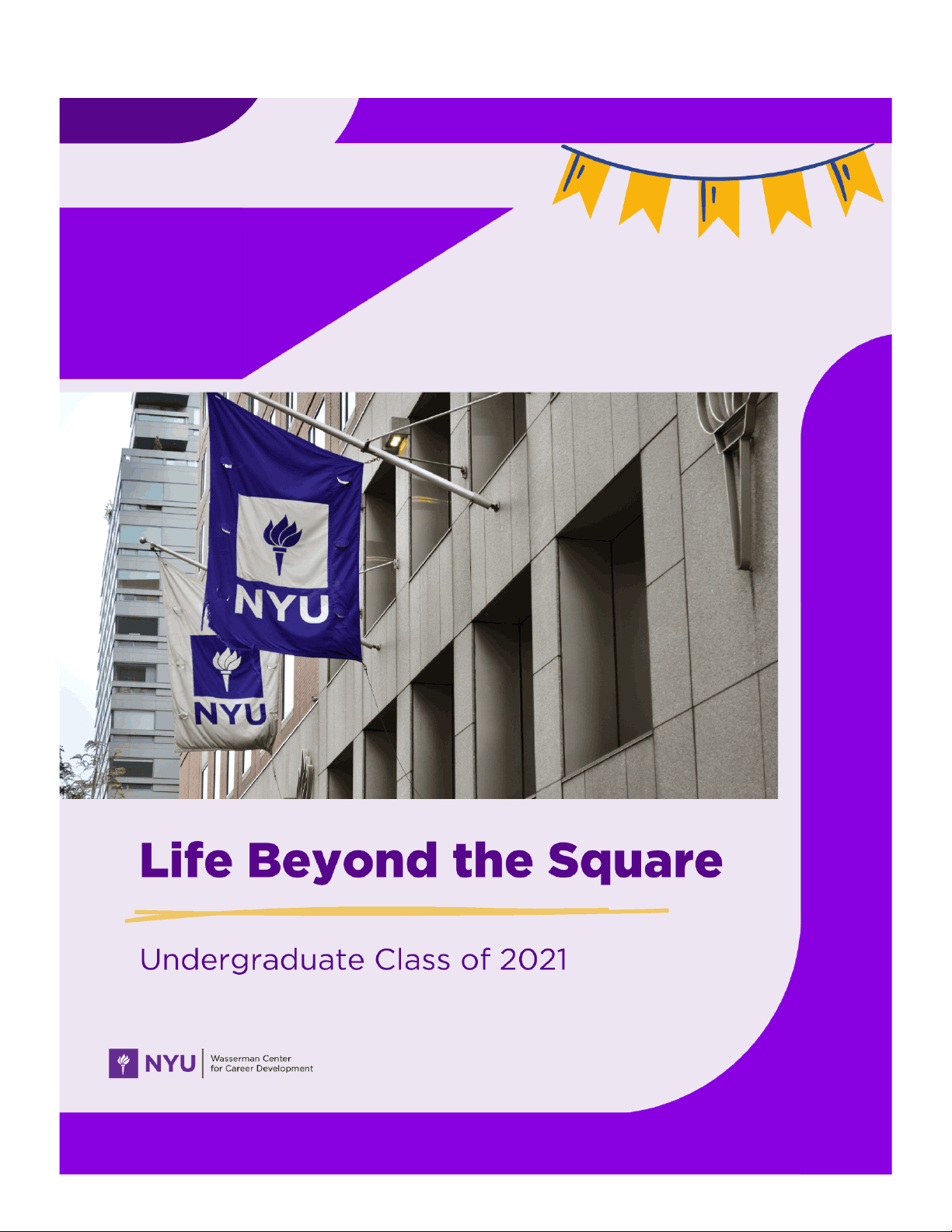
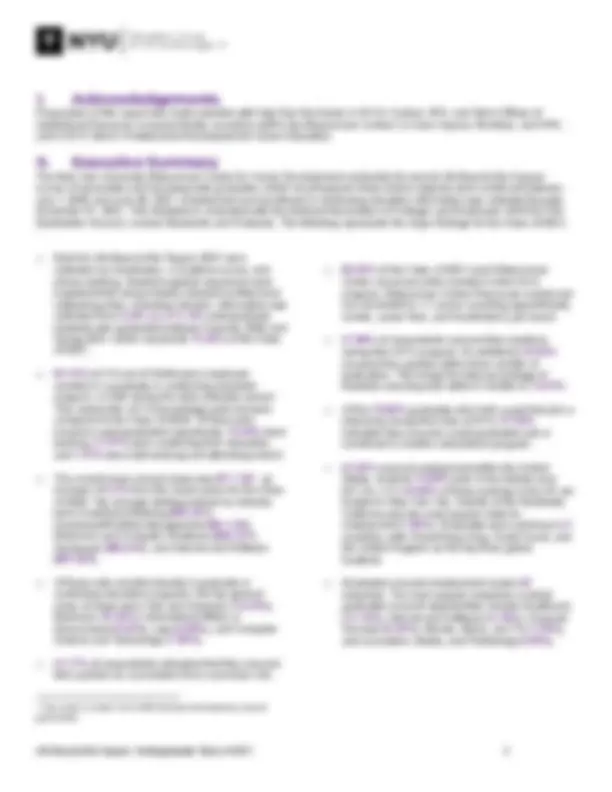
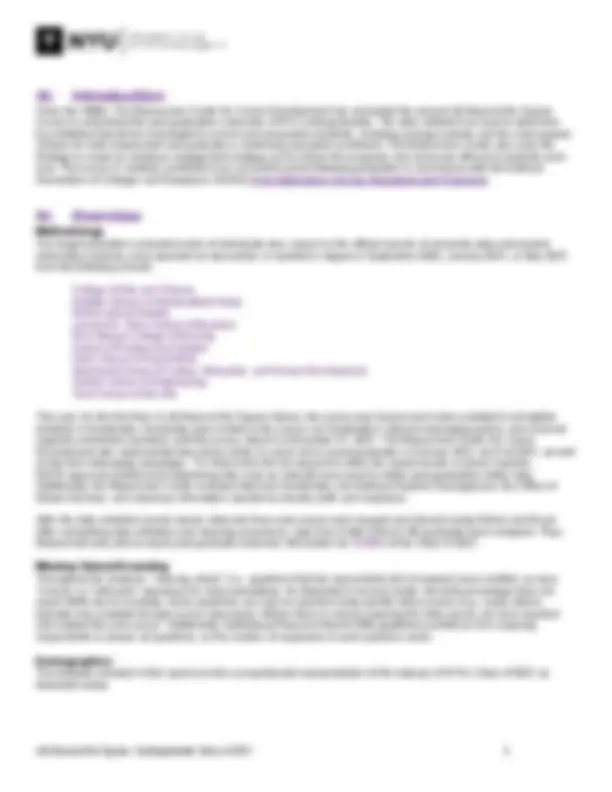
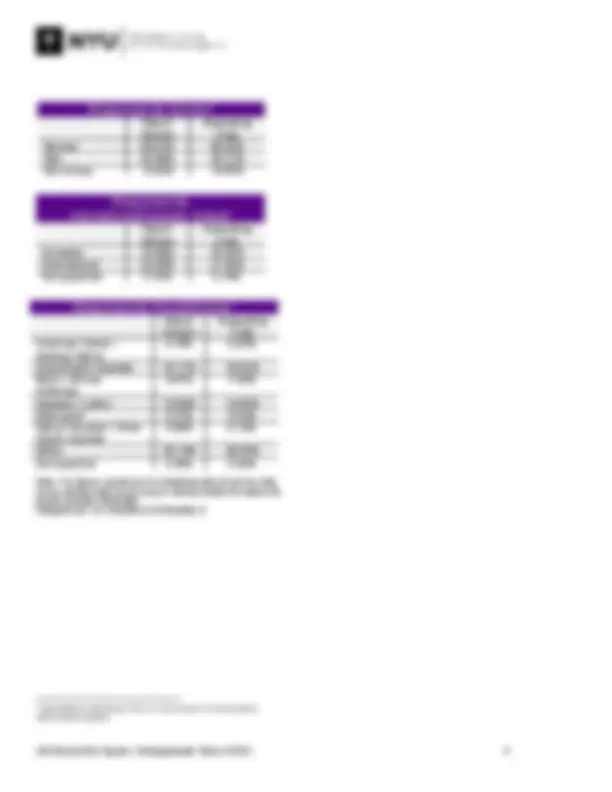
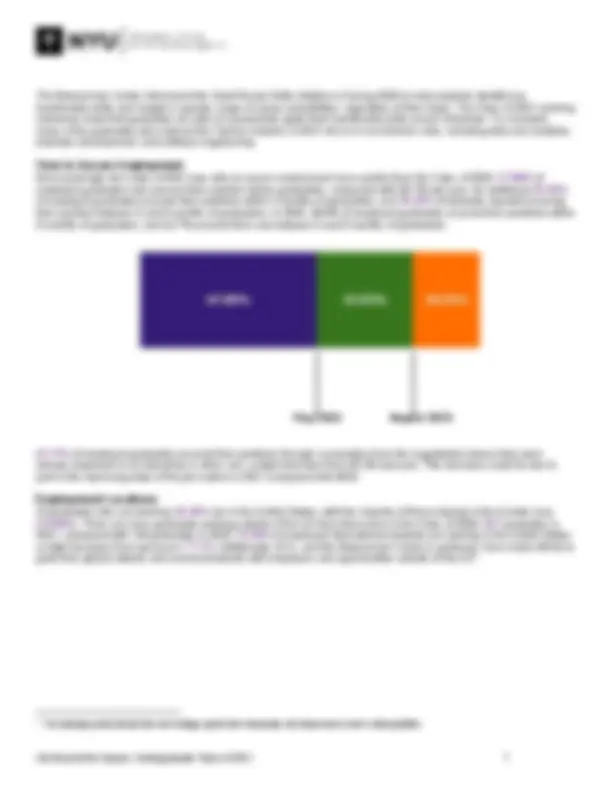
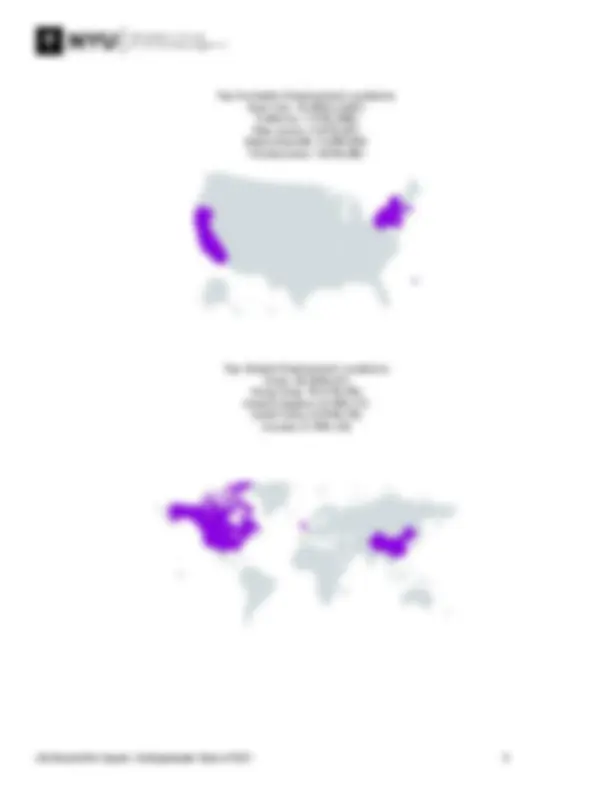
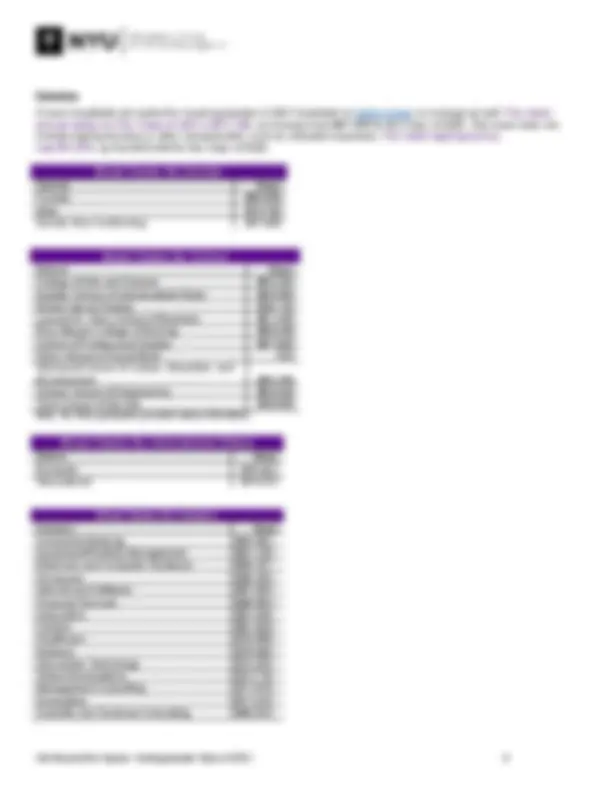


Study with the several resources on Docsity

Earn points by helping other students or get them with a premium plan


Prepare for your exams
Study with the several resources on Docsity

Earn points to download
Earn points by helping other students or get them with a premium plan
Community
Ask the community for help and clear up your study doubts
Discover the best universities in your country according to Docsity users
Free resources
Download our free guides on studying techniques, anxiety management strategies, and thesis advice from Docsity tutors
Overview. Methodology. Missing Values/Rounding. Demographics. Career Development ... nursing graduates start their job search significantly later than ...
Typology: Exercises
1 / 12

This page cannot be seen from the preview
Don't miss anything!







III. Introduction Since the 1990s, The Wasserman Center for Career Development has conducted the annual Life Beyond the Square survey to understand the post-graduation outcomes of NYU undergraduates. The data collected are used to determine key statistics that will be meaningful to current and prospective students, including average salaries and the most popular choices for both employment and graduate or continuing education enrollment. The Wasserman Center also uses the findings to create an employer engagement strategy and to inform the programs and resources offered to students each year. The survey is routinely conducted over a 6-month period following graduation in accordance with the National Association of Colleges and Employers' (NACE) First Destination Survey Standards and Protocols. IV. Overview
The target population consisted solely of individuals who, based on the official records of university data and student information systems, were awarded an associate’s or bachelor’s degree in September 2020, January 2021, or May 2021 from the following schools: College of Arts and Science Gallatin School of Individualized Study Global Liberal Studies Leonard N. Stern School of Business Rory Meyers College of Nursing School of Professional Studies Silver School of Social Work Steinhardt School of Culture, Education, and Human Development Tandon School of Engineering Tisch School of the Arts This year, for the first time in Life Beyond the Square history, the survey was housed and made available to all eligible students in Handshake. Graduates were invited to the survey via Handshake’s internal messaging system, and received regularly scheduled reminders until the survey closed on December 31, 2021. The Wasserman Center for Career Development also implemented two phone banks to reach out to recent graduates in Summer 2021 and Fall 2021, as well as two text messaging campaigns. For those who did not respond to either the repeat emails or phone inquiries, NACE-approved professional networking sites such as LinkedIn were used to obtain post-graduation status data. Additionally, the Wasserman Center included data from Handshake, the National Student Clearinghouse, the Office of Global Services, and outcomes information reported by faculty, staff, and employers. After the data collection period closed, data sets from each source were merged and cleaned using Python and Excel. After completing data validation and cleaning procedures, data from 4,345 of the 6,149 graduates were analyzed. Thus, Wasserman was able to report post-graduate outcomes information for 70.66% of the Class of 2021.
Throughout the analyses, “missing values” (i.e., questions that the respondents did not answer) were omitted, as were “Unsure” or “Unknown” responses for most calculations. As illustrated in several charts, the total percentage does not equal 100% due to rounding. Some questions can only be reported using specific data sources (e.g., salary data is typically only available through survey responses). Where there is nuance requiring the data source, we have reported and notated the sole source. Additionally, Institutional Research Board (IRB) guidelines prohibit us from requiring respondents to answer all questions, so the number of responses to each question varies.
The students included in this report provide a proportionate representation of the makeup of NYU’s Class of 2021 as illustrated below.
Report Sample Graduating Class Woman 59.61% 58.40% Man 39.36% 40.72% Non-binary <0.92% <0.65%
Report Sample Graduating Class Domestic 79.59% 78.40% International 20.25% 21.43% Not specified 0.16% 0.16%
Report Sample Graduating Class American Indian / Alaskan Native
Asian/Pacific Islander 19.17% 18.52% Black / African American
Hispanic / Latino 13.86% 14.03% Multiracial^2 5.27% 5.04% Native Hawaiian / Other Pacific Islander
White 29.14% 28.54% Not specified 5.36% 5.40% Notes: The figures reported are for individuals with at least one data source. Multiple data sources may be combined within the data set to provide complete information. Categories per U.S. Department of Education IP (^2) Identified as selecting “two or more races” in the student information system.
Handshake’s First Destination survey tool came with a built-in industry classification system, so the Class of 2021 industry categories differ from those used for the Class of 2020. Listed below are the top 20 industries employing the undergraduate Class of 2021. Healthcare is the most popular industry (12.1%) , followed by Internet and Software (9.18%) , and Financial Services (8.44%). Healthcare’s rise to the top of the list may be an indicator of increased demand for healthcare workers in the wake of the COVID-19 pandemic. Internet and Software in position two may be due to both the longer term rise in popularity of the tech industry as well as the sudden, necessary shift to a new virtual or hybrid work environment for much of the white collar workforce. Note: Industries such as Sports & Leisure, Pharmaceutical/Biotech, Telecommunications, Transportation & Logistics, Energy, Insurance, Materials/Construction, and Architecture/Landscaping each contributed less than 1.0% to the total. An “Other” category contributed to 2.09% of the total and has been omitted.
The Wasserman Center introduced the Violet Ready Skills initiative in Spring 2020 to help students identify key transferable skills and imagine a greater range of career possibilities, regardless of their major. The Class of 2021 working outcomes show that graduates are able to successfully apply their transferable skills across industries. For example, many of the graduates who entered the Fashion industry in 2021 did so in non-fashion roles, including data and analytics, business development, and software engineering.
Not surprisingly, the Class of 2021 was able to secure employment more quickly than the Class of 2020. 47.88% of employed graduates had secured their position before graduation, compared with 40.7% last year. An additional 25.93% of employed graduates secured their positions within 3 months of graduation, and 18.23% of students reported securing their position between 3 and 6 months of graduation. In 2020, 26.8% of employed graduates secured their positions within 3 months of graduation, and 22.7% secured their role between 3 and 6 months of graduation. May 2021 August 2021 23.17% of employed graduates secured their positions through a promotion from the organization where they were already employed in an internship or other role, a slight decrease from 25.2% last year. This decrease could be due in part to the improving state of the job market in 2021 compared with 2020.
Of graduates who are working, 93.36% are in the United States, with the majority of those staying in the tri-state area (79.85%). There are more graduates working outside of the US than there were in the Class of 2020; 207 graduates in 2021, compared with 144 graduates in 2020. 74.09% of employed international students are working in the United States, a slight decrease from last year’s 77.7%. Additionally, NYU, and the Wasserman Center in particular, have made efforts to grow their global network and connect students with employers and opportunities outside of the US^3. (^3) This data was pulled directly from Job Postings reports from Handshake, the Wasserman Center’s virtual platform.
A more hospitable job market for recent graduates in 2021 translates to higher wages on average as well. The mean annual salary for the Class of 2021 is $71,128, an increase from $67,546 for the Class of 2020. This mean does not include signing bonuses or other compensation, such as relocation expenses. The mean signing bonus was $11,976 , up from $10,444 for the Class of 2020.
Gender Mean Female $66, Male $76, Gender Non-Conforming $47,
School Mean College of Arts and Science $63, Gallatin School of Individualized Study $50, Global Liberal Studies $49, Leonard N. Stern School of Business $81, Rory Meyers College of Nursing $98, School of Professional Studies $67, Silver School of Social Work*^ N/A Steinhardt School of Culture, Education, and Development $50, Tandon School of Engineering $83, Tisch School of the Arts $46, Note: No Silver graduates provided salary information.
Status Mean Domestic $70, International $74,
Industry Mean Investment Banking $92, Investment/Portfolio Management $91, Electronic and Computer Hardware $90, Aerospace $89, Internet and Software $87, Financial Services $86, Automotive $81, Fashion $81, Healthcare $79, Defense $75, Information Technology $73, Telecommunications $72, Management Consulting $71, Accounting $71, Scientific and Technical Consulting $69,
Insurance $68, Pharmaceuticals $68, Commercial Banking and Credit $68, Real Estate $67, Construction $65,
Overall, 21.97% of Class of 2021 graduates are enrolled in a continuing education program full-time or pursuing a degree program while working, a significant increase from the Class of 2020’s 11.9%. For those currently not attending a post-bachelor’s program, 36.82% reported intentions to enroll in graduate or professional school in the next five years. The overall percentage of those pursuing further education is skewed upwards by the traditionally high number of social work students pursuing an advanced degree; however, the number rose across schools. The increase could be explained by the historic trend of students preferring to continue their education rather than enter the workforce in a weak economy with potentially poor job prospects. Although the pandemic’s impact on the economy has not mimicked previous economic downturns, the uncertainty surrounding the job market may have caused some recent graduates to prefer putting off entrance into the workforce.
Overall Percent Continuing Education as an Outcome 21.97% *The below figures represent the distribution by school of those graduates who are continuing education and/or working while continuing education School Percentage College of Arts & Science 33.98% Global Liberal Studies 20.95% Gallatin School of Individualized Study 33.03% Rory Meyers College of Nursing 1.76% School of Professional Studies 22.75% Silver School of Social Work 65.22% Steinhardt School of Culture, Education, and Human Development 28.71% Leonard N. Stern School of Business 4.22% Tandon School of Engineering 23.92% Tisch School of the Arts 7.66% The top 10 areas of study for those continuing education are listed below by the percentage of those enrolled.
Area of Study Percentage Arts, Social Sciences, Humanities 21.10% Business (MBA, Accounting, Finance, Economics) 18.36% International Affairs, Government or Policy (MPA, MPP, IR) 9.54% Law 8.58% Computer Science/Technology 7.99% Life Sciences, Physical Sciences 7.03% Education 5.60% Medicine/Pre-Med 4.77% Engineering 4.05% Social Work 3.10% Dentistry 2.15% Fine Arts 0.36% Theology 0.12%